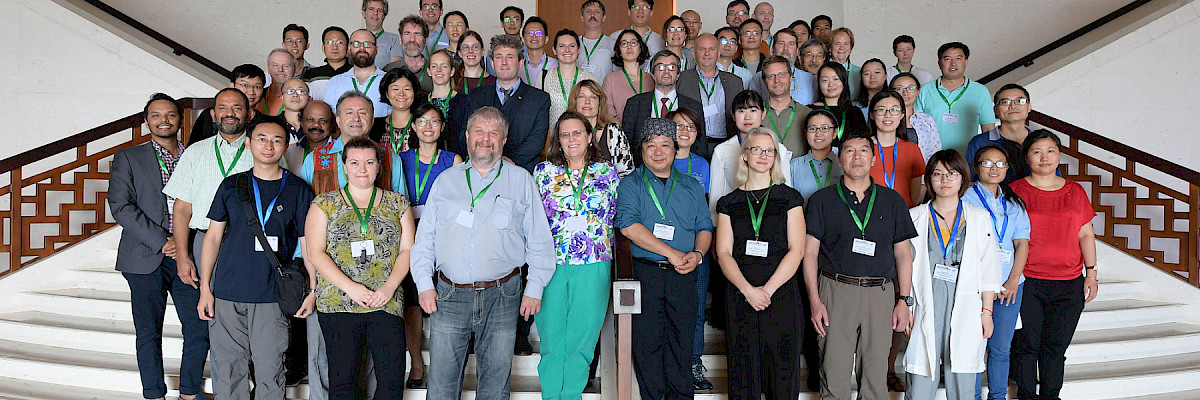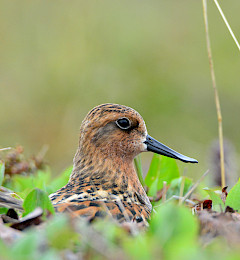
Arctic Migratory Birds Initiative (AMBI) holds workshop in Hainan, China (December 2018)
2019-02-04
December 2018—Over 85 participants from 20 countries and over 60 organizations flocked to the Arctic Migratory Birds Initiative (AMBI) East Asian-Australasian Flyway Implementation Workshop in Hainan, P.R. China December 5-8, 2018 ahead of the East Asian Australasian Flyway Partnership 10th Meeting of the Parties. This was the firstworkshop of an Arctic Council Working Group held in P.R. China, after the country became an Observer to the Arctic Council in 2013.
Observers are encouraged to make relevant contributions through their engagement in the Arctic Council Working Groups, and AMBI is of particular interest to P.R. China. "The Chinese government has attached great importance to conservation of migratory birds and their habitat,” said Lu Jun, Director of the National Bird Banding Centre of China. “Migratory birds have no nationalities, and their migration is not limited by national boundaries. Keeping migratory birds safe is the responsibility of every country along the flyway. We are willing to collaborate with the Arctic Council and other countries along the flyway to guarantee the safety of migratory birds.”
The Arctic Council’s Conservation of Arctic Flora and Fauna (CAFF), in partnership with the Department of Wildlife Conservation, National Forestry and Grassland Administration of the P.R. China, the Forestry Department of Hainan Province and the National Bird Banding Center of China, held the workshop to advance work on the issues of habitat conservation and illegal hunting of migratory birds along the flyway.
“Bird migration is unique phenomena and is the shared heritage of all our countries, so it is so natural we work together on this,” said Evgeny Syroechkovskiy, Chair of AMBI and representative of the Russian Federation Ministry of Natural Resources and Environment. “AMBI is focusing on addressing key threats to birds and their habitat on the flyway, which need urgent attention.”
The meeting brought together government representatives from environment and natural resources departments as well as foreign affairs departments in addition to key conservation organizations in the region. The workshop had representation from the Finnish Chairmanship of the Arctic Council, the US representation to the Arctic Council, the US Chairmanship of CAFF, the Arctic Athabaskan Council, the Norwegian Environment Agency, the Russian Ministry of Natural Resources and Environment, the Department of Wildlife Conservation of the National Forestry and Grassland Administration, P.R.China, the Chiangiang County Government, the National Bird Banding Centre of China, as well as Forestry Departments and/or Nature Reserves from Hainan, Guangdong, Jiangsu Hebei and Liaoning Provinces in P.R. China, academia from Beijing, Fudan, Nanjing, other Arctic Council Observer states including the Singapore National Parks Board, the Ministry of the Environment of Japan, the Republic of Korea’s National Institute of Ecology, and representatives from the Convention of Migratory Species and Department of Conservation of New Zealand, and others from organizations in India, UK, Germany, Netherlands, Bangladesh, Indonesia, and Myanmar.
During the meeting AMBI consulted with countries and organizations to finalize its draft 2019-2023 Work Plan for submission to the Arctic Council.
“Finland is pleased that this important AMBI event in China is organized during our Chairmanship in the Arctic Council,” said Tuuli Ojala of the Finnish Arctic Council Chairmanship team at the event. “The growing engagement of Observers is valuable for the Arctic Council’s work and its international role. In case of the AMBI project, we could say that the engagement of the Observers is indispensable.”
“The U.S. is pleased to see such excellent collaboration with Observer countries and organizations, it is an example for the entire Arctic Council on how we should work,” Julie Gourley, U.S. Senior Arctic Official said in her speech at the event. “I ask the countries represented here and by the Arctic Council to take seriously the recommendations of our experts in this area as they help guide and inform the critical decisions that need to be made to conserve Arctic birds now and for future generations.”
The meeting also highlighted the work of governments and organizations to advance conservation issues such as habitat protection and restoration, the development and implementation of species and habitat management strategies, and efforts to better understand and reduce illegal killing and hunting as they pertain to AMBI priority species including the Spoon-billed Sandpiper, Red Knot, Great Knot and others. It also showcased key activities and products that have helped advance conservation in the region.
“The time is now, not years from now, to work collectively to identify the management actions needed to conserve Arctic migratory birds. Under the U.S. Chairmanship of CAFF, we have prioritized AMBI to demonstrate work based on a Flyway approach that advances, conservation, informs decision making and inspires people”, said Cindi Jacobson, U.S. Chair of CAFF. “There is a great urgency then for countries and organizations to implement these actions before it is too late.”
CAFF is the biodiversity Working Group of the Arctic Council. CAFF’s mandate is to address the conservation of Arctic biodiversity, and to communicate its findings to the governments and residents of the Arctic, helping to promote practices which ensure the sustainability of the Arctic’s living resources. It does so through various monitoring, assessment and expert group activities. One such assessment, the Arctic Biodiversity Assessment (2013) noted that “Many Arctic migratory species are threatened by overharvest and habitat alteration outside the Arctic, especially birds along the East Asian flyway,” and launched AMBI as a response in 2015. Since then AMBI has been working with Arctic governments, in particular, Russia, Canada, U.S and Norway, as well as Arctic Council observer states in Asia, in particular Singapore, Japan, P.R. China, Republic of Korea and India, and other partners, to improve the status and secure the long-term sustainability of declining Arctic breeding migratory bird populations along the East Asian-Australasian Flyway and three other global flyways. In 2013 CAFF and EAAFP signed a Resolution of Cooperation in to better coordinate efforts to promote and protect birds along a migratory flyway, and CAFF is an Intergovernmental Partner to the EAAFP.
AMBI is grateful to the Chinese hosts and to all participants for their continued cooperation on the project. Following the publication of its new Work Plan 2019-2023 (anticipated in mid 2019). AMBI looks forward to continuing working with ever-expanding numbers of partners to advance common goals for Arctic-breeding migratory bird conservation.
Contact: Courtney Price, AMBI Global Coordinator, CAFF Communications Manager: Courtney@caff.is
 Arctic Council Working Group
Arctic Council Working Group 

